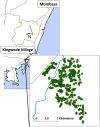Partnering parasites: evidence of synergism between heavy Schistosoma haematobium and Plasmodium species infections in Kenyan children
- PMID: 22848765
- PMCID: PMC3404100
- DOI: 10.1371/journal.pntd.0001723
Partnering parasites: evidence of synergism between heavy Schistosoma haematobium and Plasmodium species infections in Kenyan children
Abstract
Background: Residents of resource-poor tropical countries carry heavy burdens of concurrent parasitic infections, leading to high rates of morbidity and mortality. This study was undertaken to help identify the social and environmental determinants of multiple parasite infection in one such community.
Methodology/principal findings: Residents of Kingwede, Kenya aged 8 years and older were tested for presence and intensity of S. haematobium and Plasmodium spp. infections in a cross-sectional, household-based, community survey. Using General Estimating Equation (GEE) models, social and environmental determinants associated with patterns of co-infection were identified, with age being one of the most important factors. Children had 9.3 times the odds of co-infection compared to adults (95%CI=5.3-16.3). Even after controlling for age, socio-economic position, and other correlates of co-infection, intense concomitant infections with the two parasites were found to cluster in a subset of individuals: the odds of heavy vs. light S. haematobium infection increased with increasing Plasmodium infection intensity suggesting the importance of unmeasured biological factors in determining intensity of co-infection.
Conclusions/significance: Children in this community are more likely to be infected with multiple parasites than are adults and should therefore be targeted for prevention and control interventions. More importantly, heavy infections with multiple parasite species appear to cluster within a subset of individuals. Further studies focusing on these most vulnerable people are warranted.
Conflict of interest statement
The authors have declared that no competing interests exist.
Figures



Similar articles
-
Anti-Schistosoma IgG responses in Schistosoma haematobium single and concomitant infection with malaria parasites.Pathog Glob Health. 2016 Mar;110(2):74-8. doi: 10.1080/20477724.2016.1174499. Epub 2016 Apr 19. Pathog Glob Health. 2016. PMID: 27092873 Free PMC article.
-
Bladder morbidity and hepatic fibrosis in mixed Schistosoma haematobium and S. mansoni Infections: a population-wide study in Northern Senegal.PLoS Negl Trop Dis. 2012;6(9):e1829. doi: 10.1371/journal.pntd.0001829. Epub 2012 Sep 27. PLoS Negl Trop Dis. 2012. PMID: 23029589 Free PMC article.
-
Malaria and helminth co-infections in school and preschool children: a cross-sectional study in Magu district, north-western Tanzania.PLoS One. 2014 Jan 29;9(1):e86510. doi: 10.1371/journal.pone.0086510. eCollection 2014. PLoS One. 2014. PMID: 24489732 Free PMC article.
-
Advances in our understanding of the epidemiology of Plasmodium and schistosome infection: informing coinfection studies.Curr Opin HIV AIDS. 2012 May;7(3):225-30. doi: 10.1097/COH.0b013e328351b9fb. Curr Opin HIV AIDS. 2012. PMID: 22327411 Review.
-
Female genital schistosomiasis as a risk-factor for the transmission of HIV.Int J STD AIDS. 1994 Sep-Oct;5(5):368-72. doi: 10.1177/095646249400500517. Int J STD AIDS. 1994. PMID: 7819359 Review.
Cited by
-
Cytokine profiles among patients co-infected with Plasmodium falciparum malaria and soil borne helminths attending Kampala International University Teaching Hospital, in Uganda.Allergy Asthma Clin Immunol. 2018 Mar 19;14:10. doi: 10.1186/s13223-018-0235-z. eCollection 2018. Allergy Asthma Clin Immunol. 2018. PMID: 29560020 Free PMC article.
-
Schistosomiasis, soil transmitted helminthiasis, and malaria co-infections among women of reproductive age in rural communities of Kwale County, coastal Kenya.BMC Public Health. 2022 Jan 19;22(1):136. doi: 10.1186/s12889-022-12526-0. BMC Public Health. 2022. PMID: 35045848 Free PMC article.
-
Epidemiology of malaria, schistosomiasis, and geohelminthiasis amongst children 3-15 years of age during the dry season in Northern Cameroon.PLoS One. 2023 Jul 31;18(7):e0288560. doi: 10.1371/journal.pone.0288560. eCollection 2023. PLoS One. 2023. PMID: 37523402 Free PMC article.
-
Epidemiology of Plasmodium and Helminth Coinfection and Possible Reasons for Heterogeneity.Biomed Res Int. 2016;2016:3083568. doi: 10.1155/2016/3083568. Epub 2016 Mar 22. Biomed Res Int. 2016. PMID: 27092310 Free PMC article. Review.
-
Improving socioeconomic status may reduce the burden of malaria in sub Saharan Africa: A systematic review and meta-analysis.PLoS One. 2019 Jan 24;14(1):e0211205. doi: 10.1371/journal.pone.0211205. eCollection 2019. PLoS One. 2019. PMID: 30677102 Free PMC article.
References
-
- NMCP. Kenyan Ministry of Health, Division of Malaria Control. 2009
-
- King CH, Dickman K, Tisch DJ. Reassessment of the cost of chronic helmintic infection: a meta-analysis of disability-related outcomes in endemic schistosomiasis. The Lancet. 2005;365:1561–1569. - PubMed
-
- Egwunyenga AO, Ajayi JA, Nmorsi OPG, Duhlinska-Popova DD. Plasmodium/intestinal helminth co-infections among pregnant Nigerian women. Memórias do Instituto Oswaldo Cruz. 2001;96:1055–1059. - PubMed
Publication types
MeSH terms
Grants and funding
LinkOut - more resources
Full Text Sources
Medical
Miscellaneous

